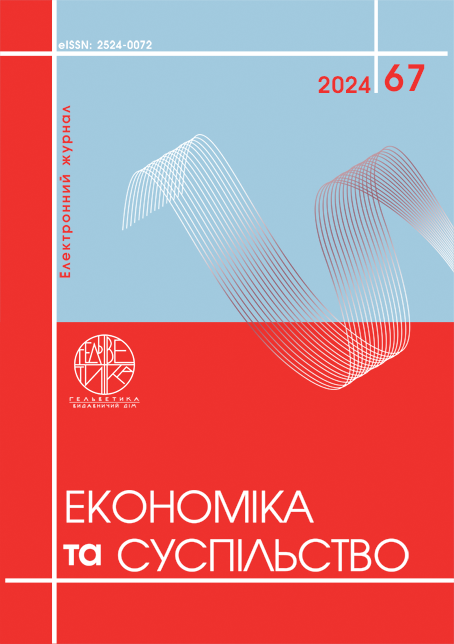MANAGEMENT PRACTICES IN ELDERLY CARE: DIFFERENCE BETWEEN MUSLIM AND JEWISH ELDERLY POPULATIONS IN ISRAELI NURSING HOMES
Анотація
In Israeli society, the perception of nursing homes differs between Arab and Jewish populations. For Arab Muslims, family plays a central role in elderly care, considering it a core value in Arab culture. This study examines the elderly's involvement in deciding to move to a nursing home and utilize formal community services. Findings show that family members in the Arab community struggle with this decision, and the high involvement of the elderly themselves provides legitimacy to the decision. Muslim families take longer to decide regarding transferring to a nursing home than Jewish families, indicating the decision's complexity. Factors contributing to this matter include limited knowledge about nursing homes, lack of adapted institutional services, and difficulty obtaining culturally aligned medical care. The study highlights the need for culturally sensitive institutional services and increased knowledge accessibility. These findings can guide policymakers and healthcare providers in developing tailored solutions to address the unique needs of Israel's elderly population across diverse cultural and religious backgrounds.
Посилання
Aboderin, I. (2004). Decline in material family support for older people in urban Ghana, Africa: Understanding processes and causes of change. The Journals of Gerontology. Series B, Psychological Sciences and Social Sciences, 59(3), S128–37. https://doi.org/10.1093/geronb/59.3.s128
Band-Winterstein, T., & Freund, A. (2013). Is it enough to 'Speak Haredi'? Cultural sensitivity in social workers encountering Jewish ultra-orthodox clients in Israel. British Journal of Social Work, 45. https://doi.org/10.1093/bjsw/bct167
Bar-Tur, L. (1993). Adjustment to home for the aged as a developmental crisis in old age. Gerontology (62), 48–57. http://www.jstor.org/stable/23482304
Bloom, D. E., Canning, D., & Fink, G. (2010). Implications of population ageing for economic growth. Oxford review of economic policy, 26(4), 583–612.
Brenner, J. M., Bird, J. B., & Willey, J. M. (2017). Formative assessment in an integrated curriculum: identifying at-risk students for poor performance on USMLE step 1 using NBME custom exam questions. Academic Medicine, 92(11S), S21–S25.
Brodsky, J., Berkman, P., Bentor, N., Berg-Warman, A., & Rasooli, I. (2010 She'elon meni'at missud la-zaken ha-gar ba-mosad [Questionnaire for prevention of institutionalization for an elderly person residing in an institution]. Myers-JDC-Brookdale Institute.
Castle, N. G., & Ferguson, J. C. (2010). What is nursing home quality and how is it measured? The Gerontologist, 50(4), 426–442. https://doi.org/10.1093/geront/gnq052
Central Bureau of Statistics. (2023, March 1). Census of collective residences and institutions, 2022 (Data set). https://www.cbs.gov.il/en/publications/Pages/2021/Collective-residences-and-institutions-2016-2018.aspx
Choi, S. J. (1996). The family and ageing in Korea: A new concern and challenge. Ageing and Society, 16(1), 1–25. https://doi.org/10.1017/S0144686X00003111
Edelstein, O. E., Band-Winterstein, T., & Bachner, Y. G. (2018). Profile and burden of care among caregivers of Ultra-Orthodox Frail Elders. Aging & Mental Health, 22(5), 639–645. https://doi.org/10.1080/13607863.2017.1289363
Eisenstadt, S. N. (2022). The absorption of immigrants: a comparative study based mainly on the Jewish community in Palestine and the State of Israel. Routledge.
Ettelt, S., Williams, L., Damant, J., Perkins, M., & Wittenberg, R. (2022). What kind of home is your care home? A typology of personalised care provided in residential and nursing homes. Ageing & Society, 42(5), 993–1013.
Gamzu, R. (2020, April 20). Magen Avot Ve-Immahot: Tokhnit le'ummit le-mattan ma'aneh le-haganna al dayyrei mosdot ha-gil ha-shlishi [Defender of fathers and mothers: National program for protecting residents of elderly care facilities]. Israel Ministry of Health, Public Health Services’ Headquarters for Struggle Against Coronavirus. https://bit.ly/3x7Gk6P
Güney, S., Karadağ, A., & El-Masri, M. (2021). Perceptions and experiences of person-centered care among nurses and nurse aides in long term residential care facilities: A systematic review of qualitative studies. Geriatric Nursing, 42(4), 816–824.
Haj‐Yahia, M. M., & Sadan, E. (2008). Issues in intervention with battered women in collectivist societies. Journal of marital and family therapy, 34(1), 1–13.
Halpert, E. (1991). Aspects of a dilemma of middle age: Whether or not to place aged, failing parents in a nursing home. The Psychoanalytic Quarterly, 60(3), 426–449.
Hoek, L. J., van Haastregt, J. C., de Vries, E., Backhaus, R., Hamers, J. P., & Verbeek, H. (2021). Partnerships in nursing homes: How do family caregivers of residents with dementia perceive collaboration with staff?. Dementia, 20(5), 1631–1648.
Ibrahim, M., & Allassad Alhuzail, N. (2022). Culturally competent social work in Arab–Palestinian locality welfare bureaus in Israel: Is it possible?. The British Journal of Social Work, 52(6), 3366–3384.
Iecovich, E. (2013). Caring for frail older people in Israel. In (pp. 257–272). https://doi.org/10.1332/policypress/9781447301066.003.0012
The Joint & The Ministry of senior citizens. (2011). Tippul bayit bi-zkenim ha-mugbbalim be-tifkudam: Sugyot, sherutim ve-tochniyot [Home care for frail older adults: Issues, services, and programs].
Jongen, C. S., McCalman, J., & Bainbridge, R. G. (2017). The implementation and evaluation of health promotion services and programs to improve cultural competency: a systematic scoping review. Frontiers in public health, 5, 24.
Kagitibasi, C. (1996). Family and human development across cultures: A View from the other side (1st). Lawrence Erlbaum Associates, Inc. https://doi.org/10.4324/9781315805993
Khalaila, R., & Litwin, H. (2012). Modernization and filial piety among traditional family caregivers: A Study of Arab-Israelis in cultural transition. Ageing and Society, 32(5), 769–789. https://doi.org/10.1017/S0144686X11000572
Knesset News. (2023, May 31). Representative of employment service to committee on status of women: 30% of income support recipients are Arab and Bedouin women. https://main.knesset.gov.il/en/news/pressreleases/pages/press31523u.aspx
Litwin, H., & Zoabi, S. (2003). Modernization and elder abuse in an Arab-Israeli context. Research on Aging, 25(3), 246-224. https://doi.org/10.1177/0164027503025003002
Manor, S. (2018). There is nobody to rely on: Cracks in the intergenerational contract among the elders in Arab society in Israel. Journal of Family Issues, 39(11), 2935–2957. https://doi.org/10.1177/0192513X18770234
Ministry for Social Equality. (2015, July 1). Ha-madriẖ la-ezraẖ ha-vatik [The guide for the elderly citizen: Rights, benefits, and information for the senior citizens in Israel]. https://bit.ly/3V50WF0
Nathanson, R., Weiss, Y., & Zilberman, E. (2018). Kshishim be-isra'el: Tmunat matsav, skira skira hashva'atit benle'ummit, nittuḥ, ve-hamlatsot mediniyut [The elderly in Israel: Status overview, international comparative review, analysis, and policy recommendations]. Macro Center for Political Economics.
Schulmann, K., Reichert, M., & Leichsenring, K. (2018). Social support and long-term care for older people: The potential for social innovation and active ageing. In The Future of Ageing in Europe: Making an Asset of Longevity (pp. 255–286). Singapore: Springer Nature Singapore.
Schuster, M., Elroy, I., & Rosen, B. (2018). How culturally competent are hospitals in Israel?. Israel Journal of Health Policy Research, 7, 1–10.
Shapira, A. (2010, December 29). Foreign workers in Israel. The Israel Democracy Institute (IDI). Parliament. https://www.idi.org.il/parliaments/11099/11108
Sheva, N. (2023, August 14). Shinnuy be-shi'urei ha-ta'asuka ba'shanim 2014–2023 [Change in employment rates in the years 2014-2023]. Knesset Research and Information Center Website.
Shnoor, Y., & Cohen, Y. (2020). +65 in Israel statistical yearly 2020 (No. 22). Myers-JDC-Brookdale Institute.
Skudlik, S., Hirt, J., Döringer, T., Thalhammer, R., Lüftl, K., Prodinger, B., & Müller, M. (2023). Challenges and care strategies associated with the admission to nursing homes in Germany: a scoping review. BMC nursing, 22(1), 5.
Surji, K. M., & Sourchi, S. M. (2020). The essential role of human resources management in healthcare and its impact on facilitating optimal healthcare services. Qalaai Zanist Journal, 5(2), 1166–1188.
Sury, L., Burns, K., & Brodaty, H. (2013). Moving in :Adjustment of people living with Dementia going into a nursing home and their families. International Psychogeriatrics, 25(6), 867–876. https://doi.org/10.1017/S1041610213000057
Truong, M., Paradies, Y., & Priest, N. (2014). Interventions to improve cultural competency in healthcare: a systematic review of reviews. BMC health services research, 14, 1–17.
Авторське право (c) 2024 Yonatan Elgabsy

Ця робота ліцензується відповідно до Creative Commons Attribution 4.0 International License.


